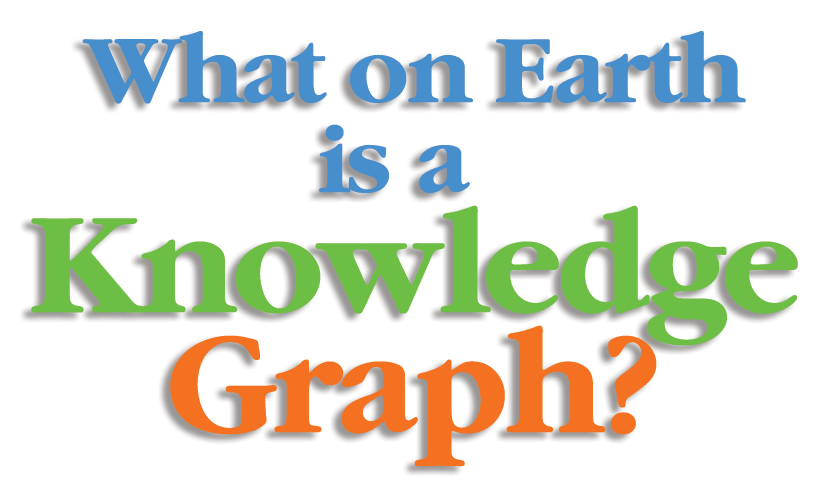What on Earth is a Knowledge Graph?

Semantic search is powered by the “Knowledge Graph”, explains David Amerland, in his groundbreaking book on SEO, “Google Semantic Search”. What on earth is the Knowledge Graph?
First, you need to understand that Google is a knowledge engine more than a search engine. It is about the business of gaining knowledge of “entities” and then compiling this knowledge so that it can match up entities better.
Were you a “Trekkie” like me?
The captain in that television show talked to the computer much like it was a staff member, by voice only. Did you ever see anyone typing the word “Engage” as the vessel took off at light speed?
In the “Next Generation” of the show, you may recall “DATA” who was a human computer. This “humanoid” creation had a habit of passionately learning as much as it could and growing smarter by the episode. It let you know too! Google is also doing that with each “entity” it discovers and builds a knowledge graph about.
The image below is a "Knowledge Graph" about "Star Trek" It appears on the search engine page when you type those words. Check it out!

Google is now the vessel and this is now the way we “engage” it. “Amit Singhal,” says Amerland, “is a Google Fellow and head of Google’s core search team. . . . Singhal happens to be a big Star Trek fan.”
When you ask Google a question in search, it looks at all the index content, the knowledge graphs, and comes up with a huge number of choices, then proceeds to narrow it down to an answer for us. Read the book to understand exactly how it does this. It is a very complex process which is much clearer when you read the full explanation.
Basically, it looks at our personal search history to try to figure out the contextual meanings of the words we type. That's because context is the final filter applied by semantic search that helps personalize the search results in respect to the search query. A query like "I want a Pizza restaurant" typed in Raleigh, NC will give different results to the exact same search query typed in Manchester, in the United Kingdom, where David Amerland lives. We won't just be given the same pizza shop!
You can actually see this live as you type. Notice the drop down shows you multiple versions of your query, narrowing it down as you type each word, until you make a choice from the phrases shown. You can actually see this "hive-mind" in action! No you can’t, but just saying that feels good. Google is scouring all the information on the web and simultaneously building knowledge graphs of everything. It connects for you just what you need at that moment.
You can see the "Knowledge Graph" on a search page. It is shown on the right side of the page. Above is the knowledge graph shown for “Star Trek” when you type that into the search box. It is on the right of the page and the list of websites is on the left. When you click on "more images", since this is primarily a visual item, you will see hundreds of images of the series.
Can you find the “Knowledge Graph” of your business? Just Google it.
How do you prepare your Web Content for the Knowledge Graph?
This is not marketing 101 but actually it is, because it is fresh information. We did not set up our marketing plans for this. Here is a small business version in my own words of the steps that “Google Semantic Search” suggests that you follow for your knowledge graph preparation:
1. What “Real Problems” does your business solve?
List a set of questions people have that your business answers. These can be questions they have asked you. What needs do you solve? List them. Seriously.
2. How do you answer these questions online?
If you haven’t yet, now is the time to do so. A great content generation plan is to envision a full set of questions and then proceed to answer them. Then post these everywhere you can online.
3. How do you collect ongoing questions as they come up?
Listening to your customers is very important. Collecting their problems and stories and divining solutions for them is a wonderful way to refine your business strategy on an ongoing basis. It keeps you current as needs change.
Make sure you have a way to collect questions. Make sure you have a way to write down the answers. Make sure you post these as they occur. You will keep your customers engaged and returning for more because they will know you really understand their needs.
On which web vehicle will you post these? If you don’t have one, now is a great time to add some type of blog posting plan to your website or social media. Who will do this? Will it be you or a staff member?
4. Don’t do that without remembering your business core message!
Go back through your list here and connect every answer to your company’s brand message. Now I am not suggesting you go pack in the keywords. That is so “last year.” Just carefully reword the answers you have written down to connect gently to your basic business purpose. Advise wisely and don’t hit people over the head with it. You want them to like reading your stuff.
If you have staff members who work for you, be sure that when they share some of these messages they do understand the connection to your business purpose. Request that they share them with the “tone” or voice you project for your business. Remember “Siri” — she always answers questions with the same kind voice.
5. Google discovers content in many different places online and yours should be there.
Remember the list you made earlier about all the different places where content about your business is located online? Make a list now if you don’t have one.
It is good that Google can find your great information in many places online. Put it in a networking site. Put it in a blog post. Put it in an ad. Put it in a guest blog on some other site. Put it in a comment you make on someone else’s social media post.
When Google finds these message bits and connects them with you, it sees the extent of your reach across the web. Draw a diagram of your message reach – for each message, you can draw lines that go out to the many places where it is posted.
If you do this for each great solution you offer, you can see the success of your new and fresh solution-based content plan as it unfolds. It is not difficult to do this. Looking at in in a diagram can give you an ongoing visual measure at a glance as you progress with your online work. White boards can be very useful for drawing this type of map so everyone in your small business can see it and add to it.
6. How do you get customer reviews?
How do you collect information from your customers? Do they comment on your blog? Do they post on “Angie’s List”? Do they post on “Yelp”? Do they post on Google? Google reviews look great, by the way, when the stars show up on your business post showing on a search engine page.
Make a plan for engaging your customers to respond. Who will collect responses and take action on them or reply to them? Google will see them whether they are bad or good, so you want to see them and respond to them as quickly as possible. That’s why you need to list all the places to check them so you don’t miss any.
7. What are all the ways you actually connect with your customers?
Do they sit in your dental chair? Call up with annoyance when the product didn’t work? Tell you who else had a better price for that item? What they say has an impact on the brand of your business. Listen. Respond. Solve problems. If people work for you, talk frequently to keep track of the experience people have with your business.
These days when people can say anything online to praise or destroy a business, this is no longer irrelevant to your future. Is it your future. And Google will show it in the knowledge graph even if you don't know about it.
8. Do you have a Social Media Crisis Response System?
You need to do this. Whoever is monitoring the social media need to connect with you and gain great answers and solutions so they can be posted immediately when a crisis happens. Better yet, answer them yourself. No one else is you. Your voice of reassurance can calm people faster.
9. Now we come to “analytics”? Do you have some?
If you put that code for Google Analytics on your website, make sure someone checks it. You decide how frequently. But don’t just look up numbers of visitors. Look up how long they stayed, how many pages they went to, how quickly they bounced away. This is a good area to work on with a professional, even if you only purchase consulting from time to time to help you set goals and measure them.
Goals? Yes. Define them. A goal can be a purchase. A goal can be a view of an article page. A goal can be a specific sequence of pages visited. Many types of goals can show you how people behave with your information. If you don’t want to do this yourself, buy this service. It’s worth it. Be creative with goals as they can measure how in detail you are fulfilling the purpose of your business.
10. Who are your competitors? How do they do things?
Make a "similar and different" chart. List each competitor and identify ways you are similar and ways you are different. You can use this information as part of your brand message. You need to clearly know and share why someone would be well served to purchase from you, visit you, or turn to you for advice.
Next Step
I love action plans. This is why I have studied this book and these plans in detail. You follow the plan. You take action. The plan shows you the next steps. You follow it and it works. The next step is Chapter Three. You can look for my next article, or you can go buy David Amerland's book and read it yourself. It is well worth it. If you want more detailed information on "Entities" and "Knowledge Graphs" so you understand how Google processes the information in detail, you will find it in his book and online video Hangouts. Just "Google" David Amerland. (This is not a link: you do the work!)

